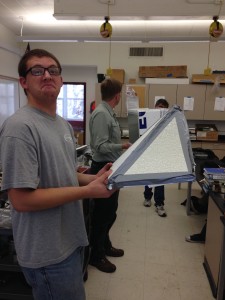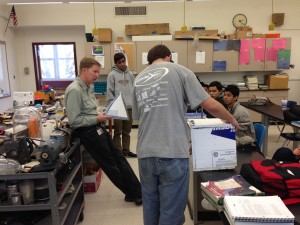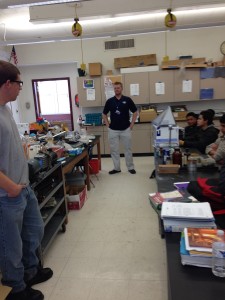I posted this over on our “High Hopes Project” blog and decided it fit well here too:
We refer to The High Hopes Project as a “model” STEM project. One aspect of that modeling is that we’ve designed it to include as many ways to participate as possible. To do so we have set up (so far) a project web site, this blog, a Twitter account, a Flickr account, a YouTube Channel, a Wiki and a Gmail account so we have access to tools like Google Forms for archiving and analyzing data.
In addition, any class or person can participate in the experiments we will send up by researching and theorizing based on what should happen, and then analyzing the data we gather and share about the atmosphere including temperature and pressure and in sending up the world’s “High Hopes” – including yours (more explanation about those aspects will be shared along the way – we don’t launch balloons until April and May) .
However another characteristic of this project is we chose 3 local schools to participate in certain engineering designs for the project to act as surrogates for all of us (an elementary, middle and high school). We contemplated opening up the major engineering design portion of this project to the world, but realized quickly that receiving design ideas from potentially tens if not hundreds of classes from around the world would be beyond our time constraints and abilities to judge and implement.
Doug Taylor who co-designed this project looks on as a student explains the mock-up of the High Hopes payload and release mechanism the class is engineering and building.
The first one of the engineering challenges the students in Mr. Walsh’s physics class at Sparks High School are tackling is how to release the “High Hopes” the world submits so they can be spread around the world – more than likely they will be printed on small strips of paper – the paper we use breaks down in the environment in a matter of weeks BTW, so our High Hopes will become one with the Earth. One batch of the High Hopes will be designed to helicopter or glide in the air (to be designed by the elementary students) and have to be released at a lower altitude, but the bulk of the High Hopes will be released as high as possible (around 100,000 feet or 33,000 meters). So that requires 2 payloads.
The students informed us a week ago that they had done some initial designing and had some mock-ups to show us, but more importantly had questions about requirements and conditions to deal with. We set up a time to meet with them and included Andy Smith who is a mechanical engineering graduate student at the University of Nevada, Reno. Andy is close to receiving his doctorate degree in engineering and has launched over 50 balloons himself, as well as designing payloads and the communications devices required to track them so they can be recovered. He has agreed to consult with students throughout the project.
 The students showed us 2 designs – one basically a pyramid shape they envision being a bit more aerodynamic and stable, and another shaped more like a rectangular prism. The rectangle design also had a rudimentary release mechanism built in. They had chosen styrofoam sheets, as the material … oh and the ever ubiquitous duct-tape.
The students showed us 2 designs – one basically a pyramid shape they envision being a bit more aerodynamic and stable, and another shaped more like a rectangular prism. The rectangle design also had a rudimentary release mechanism built in. They had chosen styrofoam sheets, as the material … oh and the ever ubiquitous duct-tape.
One question they had was about payload size. They had no idea just how many “High Hopes” they had to transport, but they assumed about a ream of paper worth (500 sheets). In fact they had placed a ream of paper inside their initial designs and dropped them from their school building as an initial test and both survived intact. We explained we really had no firm idea just how many we might receive over the months before we launch, but that their test seemed like a good start.
Andy answered their questions about release mechanisms and how to release the High Hopes at the right moment. They discussed the possibility of using arduinos they could build and program, perhaps based on altitude readings. Andy also made them aware of some of the other design issues they would have to overcome including temperature, high and very low humidity, and high winds … and that some glues and other materials don’t do well under certain conditions.
Andy answering questions about engineering design.
We’ll keep you updated as designs progress. PLEASE SIGN-UP TO BE PART OF THIS PROJECT!
Learning is Messy!!



I love the engineering component! I teach third grade at an elementary school in North Carolina – each day that we have an early release day for professional development, the students participate in an ‘Engineering Day’ in our classrooms! Our science teacher creates different challenges and information for the students according to their grade levels and needs – it’s incredible to see what the kids come up with! I enjoyed reading more about your project – it sounds like you have a great thing going!
From Brian – Thanks Taylor – yes, it is a very good thing. Please keep track of our progress and join in on anything you like. Especially the “High Hopes” part of the project – I know several teachers that are planning to do a short unit after the holidays on having their students develop their high hopes and then post them. Stay tuned for much more!